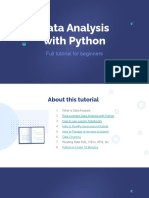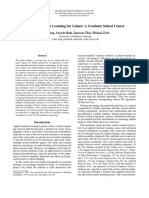Python Quick Notes
Uploaded by
SAUMYA GOELPython Quick Notes
Uploaded by
SAUMYA GOELPython Quick Notes in 2 Pages
Join our Telegram channel for more Free Resources: http://telegram.me/sqlspecialist
Follow us on Linkedin: Data Analysts Linkedin Page
● Python is a popular programming language for data analysis due to its rich
ecosystem of libraries. Key libraries for data analysis include NumPy, Pandas,
Matplotlib, and Seaborn.
NumPy:
● NumPy provides support for large, multi-dimensional arrays and matrices.
● It offers a range of mathematical functions for array manipulation.
● NumPy arrays are more memory-efficient and faster than Python lists.
Pandas:
● Pandas is used for data manipulation and analysis.
● It introduces two primary data structures: Series (1D) and DataFrame (2D).
● DataFrames are particularly useful for working with tabular data.
Data Import/Export:
● You can use Pandas to import and export data from various formats, such as
CSV, Excel, SQL databases, and more.
● Common functions include pd.read_csv(), pd.read_excel(), and
df.to_csv().
Data Cleaning:
● Use Pandas to clean and preprocess data by handling missing values and
outliers.
● Functions like df.dropna(), df.fillna(), and df.drop() are useful for
cleaning data.
Data Exploration:
● Explore data with methods like df.head(), df.tail(), df.info(), and
df.describe().
● Visualize data using Matplotlib and Seaborn for quick insights.
Data Filtering and Selection:
● Use boolean indexing to filter rows and columns based on conditions.
● Access data with .loc[] and .iloc[] for label-based and integer-based
indexing, respectively.
Data Aggregation:
● Group data with .groupby() and perform aggregation operations using
functions like sum(), mean(), and count().
Data Visualization:
● Matplotlib and Seaborn are great for creating various types of charts and
graphs.
● Customize plots with titles, labels, and legends for effective data
communication.
Machine Learning with Scikit-Learn:
● Scikit-Learn is a popular library for machine learning in Python.
● It provides tools for model training, evaluation, and prediction.
● Common steps include data preprocessing, model selection, and
performance evaluation.
Jupyter Notebooks:
● Jupyter notebooks provide an interactive environment for data analysis. You
can combine code, visualizations, and documentation in a single document.
Version Control:
● Use version control systems like Git to track changes in your data analysis
projects.
Best Practices:
● Comment your code and use meaningful variable names.
● Document your data analysis process and findings.
● Collaborate with colleagues using platforms like GitHub.
Hope it helps :)
Join now for more free resources: http://telegram.me/sqlspecialist
You might also like
- Data Analysis With Python - FreeCodeCampNo ratings yetData Analysis With Python - FreeCodeCamp26 pages
- Pandas For Everyone: Python Data Analysis: Python Data Analysis (Addison-Wesley Data & Analytics Series) - Daniel Y. ChenNo ratings yetPandas For Everyone: Python Data Analysis: Python Data Analysis (Addison-Wesley Data & Analytics Series) - Daniel Y. Chen5 pages
- Company Wise Data Science Interview Questions100% (2)Company Wise Data Science Interview Questions39 pages
- Python For Data Analysts - Quick SummaryNo ratings yetPython For Data Analysts - Quick Summary6 pages
- Data Analysis With Python: Full Tutorial For BeginnersNo ratings yetData Analysis With Python: Full Tutorial For Beginners26 pages
- Course_ Introduction to Data Science (SD211105)No ratings yetCourse_ Introduction to Data Science (SD211105)10 pages
- Data Analysis With Python - FreeCodeCampNo ratings yetData Analysis With Python - FreeCodeCamp28 pages
- Python Data Analysis Second Edition Armando Fandangoinstant download100% (1)Python Data Analysis Second Edition Armando Fandangoinstant download54 pages
- Data Analysis With Python - FreeCodeCamp PDFNo ratings yetData Analysis With Python - FreeCodeCamp PDF28 pages
- Complete roadmap to learn Python for data analysisNo ratings yetComplete roadmap to learn Python for data analysis5 pages
- Getting Started With Python Data Analysis - Sample Chapter0% (1)Getting Started With Python Data Analysis - Sample Chapter17 pages
- Chapter 2. Data Analysis and Processing - FullNo ratings yetChapter 2. Data Analysis and Processing - Full49 pages
- Interactive Data Analysis With Jupyter Cheatsheet 1731972443No ratings yetInteractive Data Analysis With Jupyter Cheatsheet 173197244310 pages
- Usage of NumPy for Numerical Data in DetailNo ratings yetUsage of NumPy for Numerical Data in Detail52 pages
- Data Analytics and Reporting - Notes Unit 1 and 2No ratings yetData Analytics and Reporting - Notes Unit 1 and 211 pages
- Python For Data Analysis Unlocking Insightsguide Brian P pdf download100% (1)Python For Data Analysis Unlocking Insightsguide Brian P pdf download87 pages
- Python Data Analytics Mastering Python For Effective Data Analysis And Visualization Floyd Bax instant downloadNo ratings yetPython Data Analytics Mastering Python For Effective Data Analysis And Visualization Floyd Bax instant download41 pages
- How To Use Python For Data Analytics A Beginner S Guide 1686513784No ratings yetHow To Use Python For Data Analytics A Beginner S Guide 168651378410 pages
- Python Programming: General-Purpose Libraries; NumPy,Pandas,Matplotlib,Seaborn,Requests,os & sys: Python, #2From EverandPython Programming: General-Purpose Libraries; NumPy,Pandas,Matplotlib,Seaborn,Requests,os & sys: Python, #2No ratings yet
- Data Science Must Work in All Industry With AI and MLNo ratings yetData Science Must Work in All Industry With AI and ML32 pages
- Health Prediction System Using Machine Learning & PythonNo ratings yetHealth Prediction System Using Machine Learning & Python17 pages
- A Review of Recurrent Neural Networks - LSTM Cells and Network Architectures (Neural Computation) (2019)No ratings yetA Review of Recurrent Neural Networks - LSTM Cells and Network Architectures (Neural Computation) (2019)36 pages
- Prediction of Mental Health (Depression) Using Data Science TechniqueNo ratings yetPrediction of Mental Health (Depression) Using Data Science Technique6 pages
- Dr. S. Vairachilai Department of CSE CVR College of Engineering Mangalpalli TelanganaNo ratings yetDr. S. Vairachilai Department of CSE CVR College of Engineering Mangalpalli Telangana18 pages
- Applied Machine Learning For Games A Graduate School CourseNo ratings yetApplied Machine Learning For Games A Graduate School Course9 pages
- The-Intersection-of-Artificial-Intelligence-and-Contemporary-Web-DevelopmentNo ratings yetThe-Intersection-of-Artificial-Intelligence-and-Contemporary-Web-Development10 pages
- Accurate Prediction of Heart Disease Using Machine Learning-A Case Study On The Cleveland Dataset - IJISRT24JUL1400No ratings yetAccurate Prediction of Heart Disease Using Machine Learning-A Case Study On The Cleveland Dataset - IJISRT24JUL14008 pages
- Mid-Sem (Odd - Sem) - 5TH & 7TH - Sem. Sep - 13, 14 & 15 2021No ratings yetMid-Sem (Odd - Sem) - 5TH & 7TH - Sem. Sep - 13, 14 & 15 20214 pages
- NeurIPS 2019 This Looks Like That Deep Learning For Interpretable Image Recognition PaperNo ratings yetNeurIPS 2019 This Looks Like That Deep Learning For Interpretable Image Recognition Paper12 pages
- Artificial Intelligence With Lab: Report: Machine LearningNo ratings yetArtificial Intelligence With Lab: Report: Machine Learning6 pages
- COMBINED Impact of AI On Green HRM PracticesNo ratings yetCOMBINED Impact of AI On Green HRM Practices26 pages
- Monte Carlo Role in Radiobiological Modelling of RNo ratings yetMonte Carlo Role in Radiobiological Modelling of R25 pages
- ABSTRACT Robotic Arm-Based Object Sorting SystemNo ratings yetABSTRACT Robotic Arm-Based Object Sorting System12 pages

























































































